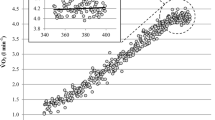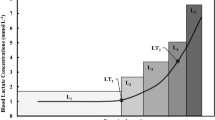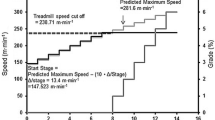Abstract
A widely cited recommendation is that to elicit valid maximal oxygen uptake (V̇O2max) values, incremental exercise tests should last between 8 and 12 minutes. However, this recommendation originated from the findings of a single experimental study conducted by Buchfuhrer et al. in 1983. Although this study is an important contribution to scientific knowledge, it should not be viewed as sufficient evidence to support the recommendation for eliciting valid V̇O2max values.
At least eight studies have reported that durations as short as 5 minutes and as long as 26 minutes elicit V̇O2max values similar to those derived from tests of 8–12 minutes’ duration. Two studies reported that the shorter test protocols elicited significantly higher V̇O2max V̇O2max values determined during tests of 8–12 minutes than during more prolonged tests, the prolonged tests were associated with maximal treadmill grades of 20–25%, compared with 6–10% in the shorter tests. Therefore, intolerable treadmill grades, rather than the prolonged test duration, may have limited the ability to elicit V̇O2max.
In view of the available evidence, test administrators, reviewers and journal editors should not view 8–12 minutes’ duration for incremental exercise tests as obligatory for valid V̇O2max determination. Current evidence suggests that to elicit valid V̇O2max values, cycle ergometer tests should last between 7 and 26 minutes and treadmill tests between 5 and 26 minutes. This is dependent on the qualification that short tests are preceded by an adequate warm-up and that treadmill grades do not exceed 15%. Current research is too limited to indicate appropriate test duration ranges for discontinuous test protocols, or protocols incorporating high treadmill grades.



Similar content being viewed by others
References
Belman MJ, Gaesser GA. Exercise training below and above the lactate threshold in the elderly. Med Sci Sports Exerc 1991; 23: 562–8
Billat VL, Flechet B, Petit B, et al. Interval training at VO2max: effects on aerobic performance and overtraining markers. Med Sci Sports Exerc 1999; 31: 156–63
Dufour SP, Ponsot E, Zoll J, et al. Exercise training in normobaric hypoxia in endurance runners: I. Improvement in aerobic performance capacity. J Appl Physiol 2006; 100: 1238–48
Guazzi M, Reina G, Tumminello G, et al. Improvement of alveolar—capillary membrane diffusing capacity with exercise training in chronic heart failure. J Appl Physiol 2004; 97: 1866–73
Hughson RL, Green HJ. Blood acid base and lactate relationships studied by ramp work tests. Med Sci Sports Exerc 1982; 14: 297–302
Kuipers H, Rietjens G, Verstappen F, et al. Effects of stage duration in incremental running tests on physiological variables. Int J Sports Med 2003; 24: 486–91
Whipp BJ, Davis JA, Torres F, et al. A test to determine parameters of aerobic function during exercise. J Appl Physiol 1981; 50: 217–21
Kang J, Chaloupka EC, Mastrangelo MA, et al. Physiological comparisons among three maximal treadmill exercise protocols in trained and untrained individuals. Eur J Appl Physiol 2001; 84: 291–5
Buchfuhrer MJ, Hansen JE, Robinson TE, et al. Optimizing the exercise protocol for cardiopulmonary assessment. J Appl Physiol 1983; 55: 1558–64
Withers R, Gore C, Gass G, et al. Determination of maximal oxygen consumption (V̇O2max) or maximal aerobic power. In: Gore CJ, editor. Physiological tests for elite athletes. Champaign (IL): Human Kinetics, 2000: 114–27
American Thoracic Society/American College of Chest Physicians. ATS/ACCP statement on cardiopulmonary exercise testing. Am J Respir Crit Care Med 2003; 167: 211–77
Romer LM. Cardiopulmonary exercise testing in patients with ventilatory disorders. In: Winter EM, Jones AM, Davison R, et al., editors. Sport and exercise physiology testing guidelines: exercise and clinical testing. London: Routledge, 2007: 179–88
Armstrong L, Balady GJ, Berry MJ, et al. ACSM’s guidelines for exercise testing and prescription. 7th ed. Philadelphia (PA): Lippincott Williams & Wilkins, 2006
Perkins GM, Owen A, Swaine IL, et al. Relationships between pulse wave velocity and heart rate variability in healthy men with a range of moderate—to—vigorous physical activity levels. Eur J Appl Physiol 2006; 98: 516–23
Maeder M, Wolber T, Atefy R, et al. Impact of the exercise mode on exercise capacity: bicycle testing revisited. Chest 2005; 128: 2804–11
Malatesta D, Simar D, Dauvilliers Y, et al. Aerobic determinants of the decline in preferred walking speed in healthy, active 65–and 80−year—olds. Pflugers Arch 2004; 447: 915–21
Ricardo DR, de Almeida MB, Franklin BA, et al. Initial and final exercise heart rate transients: influence of gender, aerobic fitness, and clinical status. Chest 2005; 127: 318–27
Mc Auley P, Myers J, Abella J, et al. Evaluation of a specific activity questionnaire to predict mortality in men referred for exercise testing. Am Heart J 2006; 151: 890e1–7
Malek MH, Coburn JW, Weir JP, et al. The effects of innervation zone on electromyographic amplitude and mean power frequency during incremental cycle ergometry. J Neurosci Methods 2006; 155: 126–33
Holmes TH. Ten categories of statistical errors: a guide for research in endocrinology and metabolism. Am J Physiol Endocrinol Metab 2004; 286: E495–501
Bishop D, Jenkins DG, Mackinnon LT. The relationship between plasma lactate parameters, Wpeak and 1−h cycling performance in women. Med Sci Sports Exerc 1998; 30: 1270–5
Billat V, Renoux JC, Pinoteau J, et al. Times to exhaustion at 100% of velocity at V̇O2max and modelling of the time—limit/velocity relationship in elite long—distance runners. Eur J Appl Physiol 1994; 69: 271–3
Weston SB, Gray AB, Schneider DA, et al. Effect of ramp slope on ventilation thresholds and V̇O2peak in male cyclists. Int J Sports Med 2002; 23: 22–7
Pollock ML, Foster C, Schmidt D, et al. Comparative analysis of physiologic responses to three different maximal graded exercise test protocols in healthy women. Am Heart J 1982; 103: 363–73
Pollock ML, Bohannon RL, Cooper KH, et al. A comparative analysis of four protocols for maximal treadmill stress testing. Am Heart J 1976; 92: 39–46
Froelicher Jr VF, Brammell H, Davis G, et al. A comparison of three maximal treadmill exercise protocols. J Appl Physiol 1974; 36: 720–5
Bishop D, Jenkins DG, Mackinnon LT. The effect of stage duration on the calculation of peak V̇O2 during cycle ergometry. J Sci Med Sport 1998; 1: 171–8
Myers J, Buchanan N, Walsh D, et al. Comparison of the ramp versus standard exercise protocols. J Am Coll Cardiol 1991; 17: 1334–42
Midgley AW, Mc Naughton LR, Carroll S. Time at V̇O2max during intermittent treadmill running: test protocol dependent or methodological artefact? Int J Sports Med 2007 Nov; 28 (11): 934–9
Nordrehaug JE, Danielsen R, Stangeland L, et al. Respiratory gas exchange during treadmill exercise testing: reproducibility and comparison of different exercise protocols. Scand J Clin Lab Invest 1991; 51: 655–8
Mc Connell TR, Clark BA. Treadmill protocols for determination of maximum oxygen uptake in runners. Br J Sports Med 1988; 22: 3–5
Midgley AW, Mc Naughton LR, Carroll S. Reproducibility of time at or near V̇O2max during intermittent treadmill running. Int J Sports Med 2007; 28: 40–7
Shephard RJ, Rankinen T, Bouchard C. Test—retest errors and the apparent heterogeneity of training response. Eur J Appl Physiol 2004; 91: 199–203
Bentley DJ, Mc Naughton LR. Comparison of Wpeak, V̇O2peak and the ventilation threshold from two different incremental exercise tests: relationship to endurance performance. J Sci Med Sport 2003; 6: 422–35
Mc Connell TR. Practical considerations in the testing of V̇O2max in runners. Sports Med 1988; 5: 57–68
Potiron-Josse M. Comparison of 3 protocols of determination of direct V̇O2max amongst 12 sportsmen. J Sports Med Phys Fitness 1983; 23: 429–35
Caputo F, Mello MT, Denadai BS. Oxygen uptake kinetics and time to exhaustion in cycling and running: a comparison between trained and untrained subjects. Arch Physiol Biochem 2003; 111: 461–6
Midgley AW, Mc Naughton LR, Carroll S. Physiological determinants of time to exhaustion during intermittent treadmill running at V̇O2max. Int J Sports Med 2006; 28: 273–80
Hill DW, Poole DC, Smith JC. The relationship between power and the time to achieve V̇O2max. Med Sci Sports Exerc 2002; 34: 709–14
Agostoni P, Bianchi M, Moraschi A, et al. Work—rate affects cardiopulmonary exercise test results in heart failure. Eur J Heart Fail 2005; 7: 498–504
Tamesis B, Stelken A, Byers S, et al. Comparison of the Asymptomatic Cardiac Ischemia Pilot and modified Asymptomatic Cardiac Ischemia Pilot versus Bruce and Cornell exercise protocols. Am J Cardiol 1993; 72: 715–20
Shephard RJ. Tests of maximum oxygen intake. A critical review. Sports Med 1984; 1 (2): 99–124
Barnard RJ, Gardner GW, Diaco NV, et al. Cardiovascular responses to sudden strenuous exercise: heart rate, blood pressure, and ECG. J Appl Physiol 1973; 34: 833–7
Barnard RJ, Mac Alpin R, Kattus AA, et al. Ischemic response to sudden strenuous exercise in healthy men. Circulation 1973; 48: 936–42
Midgley AW, Mc Naughton LR, Carroll S. Verification phase as a useful tool in the determination of the maximal oxygen uptake of runners. Appl Physiol Nutr Metab 2006; 31: 541–8
Rossiter HB, Kowalchuk JM, Whipp BJ. A test to establish maximum O2 uptake despite no plateau in the O2 uptake response to ramp incremental exercise. J Appl Physiol 2006; 100: 764–70
Acknowledgments
No sources of funding were used to assist in the preparation of this review. The authors have no conflicts of interest that are directly relevant to the content of this review.
Author information
Authors and Affiliations
Corresponding author
Rights and permissions
About this article
Cite this article
Midgley, A.W., Bentley, D.J., Luttikholt, H. et al. Challenging a Dogma of Exercise Physiology. Sports Med 38, 441–447 (2008). https://doi.org/10.2165/00007256-200838060-00001
Published:
Issue Date:
DOI: https://doi.org/10.2165/00007256-200838060-00001




